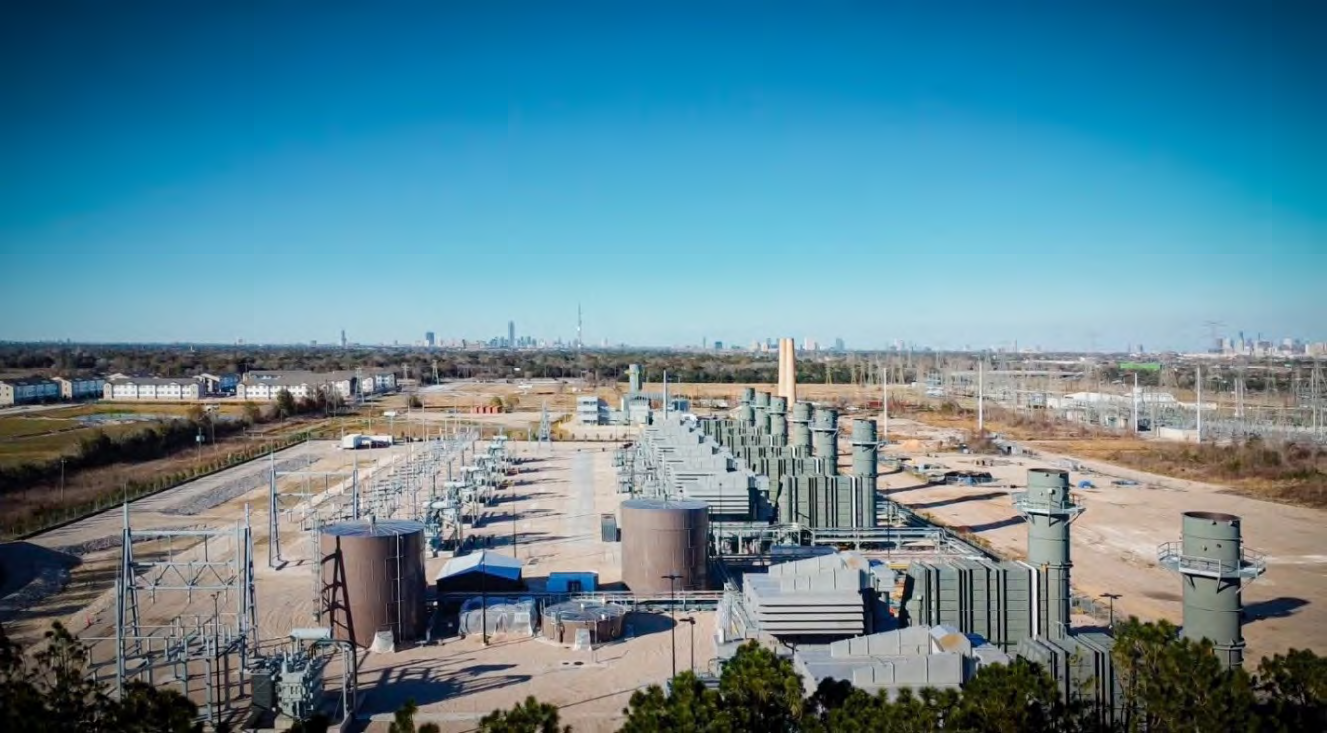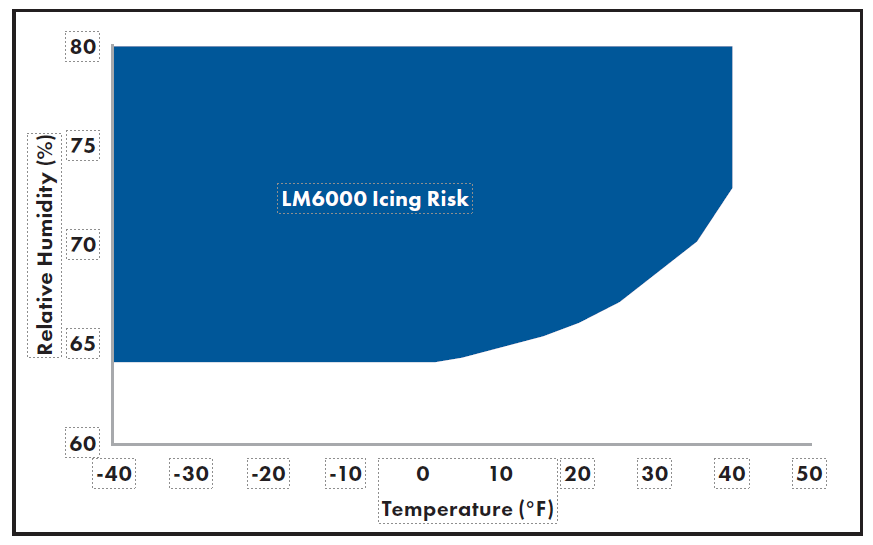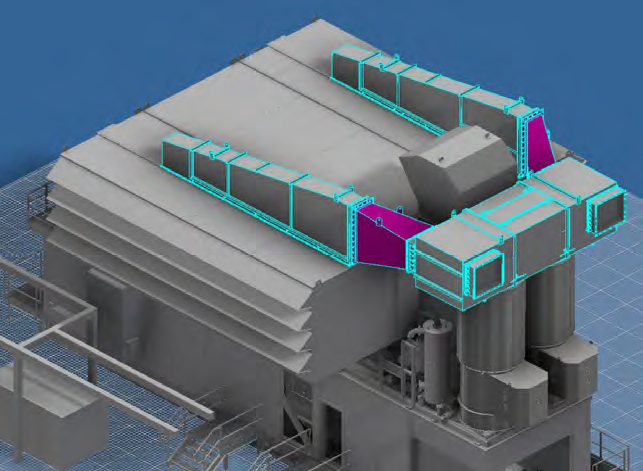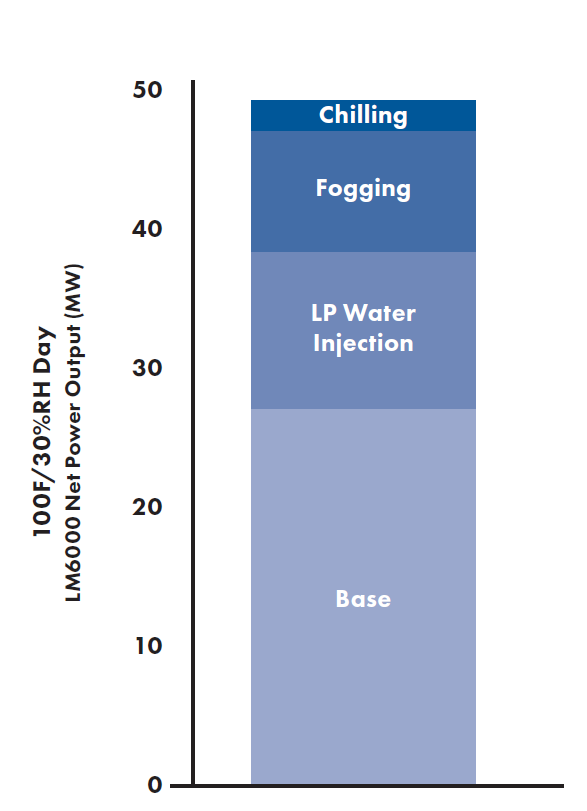POWER RESILIENCE
DESIGNING AERODERIVATIVE PLANTS FOR RESILIENCE
Figure 1: With six LM6000 units commissioned ahead of Winter Storm Uri by EPC contractor ProEnergy, the HO Clarke Generating Station generated continuous power to meet emergency capacity needs. Courtesy of ProEnergy.

Winter Storm Uri crippled infrastructure across the United States in February 2021. Texas was particularly hard hit: reports estimate that 69% of residents lost power and financial losses totaled $130 billion. No single generation type can take responsibility for the catastrophic blackouts. Instead, the least resilient facilities across all types of generation led to 60% less available capacity in the ERCOT market.
However, a new plant in Houston, Texas—a result of designing specifically for resilience—proved reliable in the historic storm. HO Clarke Generating Station (Figure 1) was created to meet the demands of typical Gulf Coast heat and increasingly common cold snaps. Owned by independent power producer (IPP) WattBridge, the plant leveraged a standardized design that enabled the 6xLM6000 facility to be commissioned two months ahead of schedule and fortuitously, a week before the storm began. The facility remained available throughout the weather event.
Figure 2: The LM6000 icing envelope puts power plants at risk below 40°F (4.4°C). Courtesy of ProEnergy.

AERODERIVATIVE PEAKERS
Policymakers and industry experts agree that fast, flexible, and dispatchable power is necessary for grid firming. In the United States, most major utilities rely on gas peakers to augment their coal retirements and support their growing renewables portfolio.
Aeroderivative gas turbines—the prevailing peaking power technology—are valued for full power fast starts in less than 10 minutes; low turn-down for loads with low unit emissions compliance; rapid load following of up to 25 MW/min, per unit; and minimal maintenance penalties for frequent starts. They offer modular power output, flexibility, efficiency, and reliability.
A single 300-MW frame turbine drops in efficiency and produces higher emissions when operating at 50% turndown. A six unit 300 MW aero facility, in comparison, can operate three units at full load. In the event of a turbine failure, only 17% of the total output is lost.
But aero peakers face economic hurdles as they operate with a low capacity factor, impacting revenue projections. This can make project financing difficult. One way around this is to stick to a standardized plant design and have a ready supply of replacement turbines available. This approach can deliver competitive installed costs.
DESIGN CONSIDERATIONS
Combustion turbine-generator (CTG) packages must be designed for both cold and hot conditions: anti-icing systems drive resilience in cold weather operation and power augmentation maintains output in hot weather operation.
In cold weather, the goal is keeping the facility online; a plant in Texas, however, will not require the same strategy as one in Minnesota. Anti-icing systems—traditionally overlooked in warmer climates—ensure sustained cold weather operation. Turbine icing begins at 40°F (4.4°C) (Figure 2), which means that most facilities in the world may experience icing at some point.
Though located in the warm Gulf Coast, the HO Clarke site is equipped with a package air recirculation system (Figure 3). It draws heated air from the engine compartment and recirculates it to the inlet air module. The system leverages waste heat from the turbine compartment and uses existing package exhaust fans to eliminate icing with minimal parasitic output losses.
Several other anti-icing technologies can be used to address turbine icing. These include compressor discharge pressure (CDP) bleed air recirculation, exhaust gas recirculation, and glycol heater and coil system. Regardless of the type of technology, any system only needs to raise the inlet air temperature by 5 to 10°F to eliminate icing risk.
Figure 3: The ProEnergy anti-icing system recirculates heated air from the engine compartment for zero parasitic losses. Courtesy of ProEnergy.

For balance of plant (BOP) winterization, designers must balance operational strategies and procedures with costs. HO Clarke used water line recirculation, temporary insulation jackets, and temporary electrically heated enclosures. BOP designs should also minimize single-point failures that can reduce power output to include sufficient water and backup fuel storage, facility winterization, redundancy, and civil seismic/wind rating. Besides these package and BOP considerations, a comprehensive operations strategy, coupled with remote monitoring and diagnostic capabilities, helps to ensure continuous availability.
POWER AUGMENTATION
In hot weather, the goal is to maximize power output or minimize lapses in power output.
Turbine output is directly related to relative humidity and inversely related to temperature: as temperature increases, power output decreases. At 100°F (38°C) and 30% relative humidity, the base performance of an LM6000 engine degrades from 50 MW to approximately 27 MW (Figure 4). By implementing power augmentation strategies, such as low-pressure water-spray power augmentation, inlet fogging, evaporative cooling, and inlet chilling and coils, power can be returned to nameplate capacity.
Figure 4: Together, chilling, inlet fogging, and low-pressure water spray can augment LM6000 power to nameplate capacity despite high temperatures. Courtesy of ProEnergy.

Developers should carefully select power augmentation technologies to optimize the power benefit against CAPEX and OPEX. Factors to consider: Water-spray technologies and inlet fogging both require a consistent flow of demineralized water; evaporative cooling requires a separate, higher conductivity water feed, and causes increased static pressure on the turbine inlet, which results in efficiency loss; inlet chilling and coil systems tend to be both complex and costly. Given the annual number of hot Texas days combined with an ample supply of demineralized water, HO Clarke opted for water-spray augmentation and inlet fogging as the best way to maintain nameplate output.
GAS AND WATER SUPPLY
Firm gas supply and adequate pressure are essential to resilience. Peaking facilities built on under-pressured fuel lines typically depend on gas compressors, which add significant expense in addition to a being a common operational point of failure. Because gas supply and gas compression can impact the economic validity of a project, designers must seek strategic access to reliable gas lines as was done with HO Clarke.
Implementing dual-fuel operations can bolster facility resilience. Using diesel fuel backed by adequate storage can provide valuable operational flexibility in emergency situations. Independent System Operators (ISOs) like ERCOT and PJM now provide guidance on days of fuel storage required.
Implementing dual-fuel operations can bolster facility resilience.
Given the potentially long-duration runs in the Gulf Coast of Texas, a 375,000-gallon water tank was added at HO Clarke that supports facility operation for approximately 14 hours. Concrete pads were also added for any needed rental demineralization trailers to augment existing systems.
Additionally, there are electrical design considerations needed to address redundancy and failures. This can include selecting how many turbine-generator packages should feed a generator step-up transformer, a well-thought-out breaker and disconnect switch configuration, and the use of double-ended switchgear. Emergency systems must be configured for the intended response strategy—whether to safely shut down or to continue with normal operations. In addition, blackstart capability can provide a means to get back online independent of a utility backfeed, as well as enable owners to improve project economics by participating in that ancillary service.
CONCLUSION
As extreme weather events—such as heat waves, droughts, wildfires, polar vortexes, and floods—challenge grid stability, the world will likely need an “all-of-the-above” solution to grid resilience. These include transmission infrastructure expansions, demand response management, long-duration energy storage, and alternative fuels. No matter the solution, peaker plants with resilient designs will remain the backstop to grid stability. ■
Ammar Moosa is Director Commercial Operations at ProEnergy. He holds
a BASc in Chemical Engineering from the University of Waterloo and an MEng in Chemical Engineering from the University of Toronto. For more information visit proenergy services.com or email amoosa@proenergyservices.com

